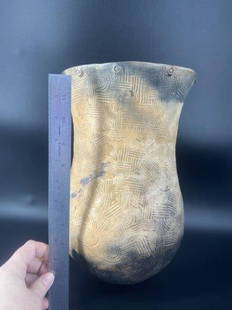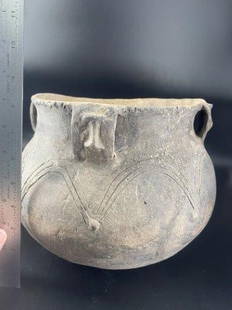
UNIDENTIFIED TLINGIT ARTIST, Raven Rattle, c. 1880s
Similar Sale History
View More Items in Tribal & Native American Artifacts

Related Tribal & Native American Artifacts

More Items in Tribal & Native American Artifacts
View MoreRecommended Art
View More







Item Details
Description
Lot 84
UNIDENTIFIED TLINGIT ARTIST
Raven Rattle, c. 1880s
maple wood and pigments, 5 x 11 x 3.5 in (12.7 x 27.9 x 8.9 cm), measurements reflect dimensions without custom stand
Provenance
Letty Washburn, wife of the vice president of the Alaska Steamship Company;
Collection of Mr. & Mrs. W.R. Holman (the Holman’s were early settlers and prominent citizens in Pacific Grove, CA.);
by descent in the family;
A Vancouver Collection.
Raven rattles are some of the most iconic objects representing Northwest Coast cultures. Originating with the Tsimshian/Nishga’a of the Nass River valley, the tradition spread out among the Tlingit, Haida, Haisla, Heiltsuk and other nations as distant as the Kwakwaka'wakw of Vancouver Island. Many variations of the basic figures that make up the raven rattle appear in the historic record, but the primary ones at the core of the tradition are the flying raven itself, the man reclining on its back, and the tail-bird, which appears in two types, facing forward and facing aft. The image has been said to represent a kingfisher.
This rattle features the basic imagery with the tail facing aft, and includes a small frog situated on the man’s chest, its tongue entering the man’s mouth. This tongue connection is a metaphor for the transfer of esoteric secrets and knowledge, and appears between the man and the tail-bird when it is facing forward and no frog is present. The typical paint colors of black, red, and blue-green appear to be all Native pigments.
This rattle exhibits the classic sweep of the wings, up the neck to the head and out to the tip of the beak. The body of the reclining man does not touch the raven’s back, and his short legs and feet contact the ends of the tail-bird’s head-feathers. The tail sits on an unusual, raised platform instead of the rounded end of the raven’s body, but its function is the same. On the raven’s breast, the recurved beak of that face is often said to represent a hawk, but it may be more likely Raven-At-The-Head-Of-The-Nass. The carving and painting of this face are rough and asymmetrical, as is much of the other painting onboard. The classic forms of the overall sculpture suggest that the carver had a history with the tradition and was not a first-time rattle-maker. Perhaps an older man carved this rattle when his eyes and hands were less well guided.
Steven C. Brown
References: For a Tlingit rattle c. of similar form from c. 1850 see Steven C. Brown, Native Visions: Evolution in Northwest Coast Art from the Eighteenth through the Twentieth Century, (Seattle: Seattle Art Museum / Vancouver: Douglas & McIntyre, 1998), fig. 4.39, p. 86. For a Tsimshian rattle of similar composition see Aldona Jonaitis, From the Land of the Totem Poles: The Northwest Coast Indian Art Collection at the American Museum of Natural History, (New York: AMNH, 1988), pl. 25. See also Bill Holm and William Reid, Form and Freedom: A Dialogue on Northwest Coast Indian Art, (Houston: Institute for the Arts, Rice University, 1975), no. 79; and Bill Holm, The Box of Daylight: Northwest Coast Indian Art, (Seattle, WA: Seattle Art Museum/University of Washington Press, Seattle, 1983), cats. 12-14, pp. 26-27.
UNIDENTIFIED TLINGIT ARTIST
Raven Rattle, c. 1880s
maple wood and pigments, 5 x 11 x 3.5 in (12.7 x 27.9 x 8.9 cm), measurements reflect dimensions without custom stand
Provenance
Letty Washburn, wife of the vice president of the Alaska Steamship Company;
Collection of Mr. & Mrs. W.R. Holman (the Holman’s were early settlers and prominent citizens in Pacific Grove, CA.);
by descent in the family;
A Vancouver Collection.
Raven rattles are some of the most iconic objects representing Northwest Coast cultures. Originating with the Tsimshian/Nishga’a of the Nass River valley, the tradition spread out among the Tlingit, Haida, Haisla, Heiltsuk and other nations as distant as the Kwakwaka'wakw of Vancouver Island. Many variations of the basic figures that make up the raven rattle appear in the historic record, but the primary ones at the core of the tradition are the flying raven itself, the man reclining on its back, and the tail-bird, which appears in two types, facing forward and facing aft. The image has been said to represent a kingfisher.
This rattle features the basic imagery with the tail facing aft, and includes a small frog situated on the man’s chest, its tongue entering the man’s mouth. This tongue connection is a metaphor for the transfer of esoteric secrets and knowledge, and appears between the man and the tail-bird when it is facing forward and no frog is present. The typical paint colors of black, red, and blue-green appear to be all Native pigments.
This rattle exhibits the classic sweep of the wings, up the neck to the head and out to the tip of the beak. The body of the reclining man does not touch the raven’s back, and his short legs and feet contact the ends of the tail-bird’s head-feathers. The tail sits on an unusual, raised platform instead of the rounded end of the raven’s body, but its function is the same. On the raven’s breast, the recurved beak of that face is often said to represent a hawk, but it may be more likely Raven-At-The-Head-Of-The-Nass. The carving and painting of this face are rough and asymmetrical, as is much of the other painting onboard. The classic forms of the overall sculpture suggest that the carver had a history with the tradition and was not a first-time rattle-maker. Perhaps an older man carved this rattle when his eyes and hands were less well guided.
Steven C. Brown
References: For a Tlingit rattle c. of similar form from c. 1850 see Steven C. Brown, Native Visions: Evolution in Northwest Coast Art from the Eighteenth through the Twentieth Century, (Seattle: Seattle Art Museum / Vancouver: Douglas & McIntyre, 1998), fig. 4.39, p. 86. For a Tsimshian rattle of similar composition see Aldona Jonaitis, From the Land of the Totem Poles: The Northwest Coast Indian Art Collection at the American Museum of Natural History, (New York: AMNH, 1988), pl. 25. See also Bill Holm and William Reid, Form and Freedom: A Dialogue on Northwest Coast Indian Art, (Houston: Institute for the Arts, Rice University, 1975), no. 79; and Bill Holm, The Box of Daylight: Northwest Coast Indian Art, (Seattle, WA: Seattle Art Museum/University of Washington Press, Seattle, 1983), cats. 12-14, pp. 26-27.
Condition
The absence of condition does not imply that an item is free from defects, nor does a reference to particular defects imply the absence of any others. Our team can provide thorough and comprehensive condition reports and additional images. We welcome your enquiries at info@firstarts.ca or 647-286-5012.
NOTE
Many countries prohibit or restrict importation or exportation of property containing ivory, whale bone, sealskin, and/or products derived from other endangered or protected species, and require special licenses or permits in order to import or export such property. It is the responsibility of the buyer to ensure that the item is properly and lawfully exported / imported.
NOTE
Many countries prohibit or restrict importation or exportation of property containing ivory, whale bone, sealskin, and/or products derived from other endangered or protected species, and require special licenses or permits in order to import or export such property. It is the responsibility of the buyer to ensure that the item is properly and lawfully exported / imported.
Buyer's Premium
- 23%
UNIDENTIFIED TLINGIT ARTIST, Raven Rattle, c. 1880s
Estimate CA$25,000 - CA$35,000
35 bidders are watching this item.
Shipping & Pickup Options
Item located in Toronto, ON, caSee Policy for Shipping
Local Pickup Available
Payment

TOP



































![UNIDENTIFIED TLINGIT ARTIST, Feast Tray, c. 1850: UNIDENTIFIED TLINGIT ARTIST Feast Tray, c. 1850 wood, 34.5 x 9 x 4.5 in (87.6 x 22.9 x 11.4 cm) unsigned; inscribed indistinctly in graphite in an unknown hand, "WSS[?] ?" Provenance Private Collectio](https://p1.liveauctioneers.com/7222/249743/129652566_1_x.jpg?height=310&quality=70&version=1653677113)












































![[Custer, Little Big Horn] Eagle Elk, Oglala Sioux Warrior: “I was about 25 the summer we fought Long Hair and I still believed we could drive the white men from our country. I’m a little sad yet about that fight, although it was our finest victory.”](https://p1.liveauctioneers.com/7226/322253/173251540_1_x.jpg?height=310&quality=70&version=1710004847)
